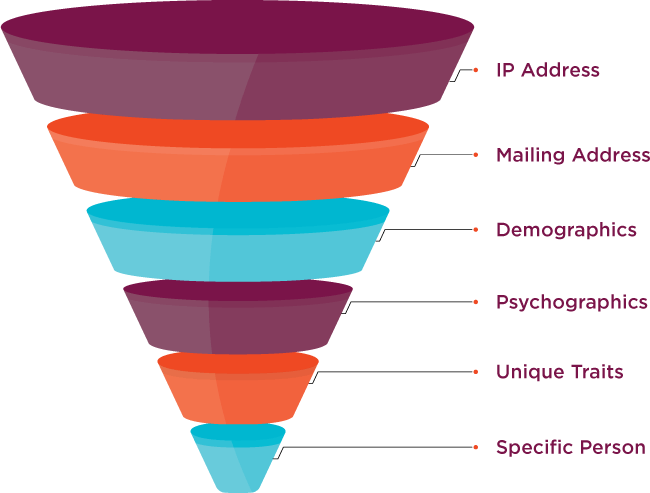Privacy is important, and Shutterfly Business Solutions supports steps taken by the United States government, private industries, and technology platforms to protect personal data. Our operations comply with several data standards like SOC2 and are HITRUST certified.
No question that protecting privacy is important. However, doing so creates a massive challenge for marketers. They can no longer track and identify website visitors who don’t submit a form, create an account, or supply an email.
Is there a way marketers can identify anonymous website users and follow up? Yes.
Shutterfly Business Solutions can identify anonymous website visitors AND comply with privacy laws. We’ll explain how we close the divide between anonymous website visitors and actual people with a physical address that can be targeted with personalized direct mail.
Send personalized direct mail to anonymous website visitors with IP address marketing
Shutterfly Business Solutions can, with a very high degree of certainty, identify anonymous website users.
The process begins with an internet protocol (IP) address.
Every device online has an IP address. Each IP address is tied to a location. See for yourself using whatismyipaddress.com.
The location could be any place — a single home with five people or an apartment with 500 residents. So we combine the location information with browsing behavior and other sophisticated models. That is how Shutterfly Business Solutions successfully identifies a significant percentage of web users so you can market to them appropriately.
Let’s explore an example of how models help us zero in on a specific person.
Finding your exact customer in the mailing address haystack
At this point in the identification process, you have an address. You also have an age group, gender, education, and other details. Now it’s time to filter the audience pool with a fine sieve.
How? By relying on your past customer data and behavior models. Often there are nuggets in your customer data platform (CDP) that reveal who was shopping on your site.
Here’s a real-world example of that.
A company that sells a unique recreational vehicle found that a very high percentage of their audience also owned a Corvette and a truck. With that insight, they cross-referenced mailing addresses with motor vehicle records for Corvette and truck owners. That zeroed in on specific people. Match that to exact addresses, and you’ve likely found the previously anonymous website visitor.
This type of filtering is how Shutterfly Business Solutions can say with a high degree of certainty which person at an address was looking at your website.
In the case of larger properties, like apartments, the process creates a list of like-minded candidates that could also be targeted.

Scoring anonymous customers to maximize your direct mail marketing ROI
Not every website user is an A+ lead. Many surfers (does anyone still say that) are lookie-loos. You don’t want to go through the time and expense of identifying every web visitor’s home address. Therefore, you should score each visitor to assess if they present a sales opportunity.
There are several ways to score website visitors. Some of the most popular metrics include:
- Time on-site
- Number of pages visited
- Number of times visiting the site
- Which pages they visited
- Which tools/functions they used on the site
- What brought them to the site (we’ll cover that in our attribution section)
Using those factors can create a score for anonymous website visitors. The score they earn dictates the action you would take.
- High Scores: Premium direct mail (envelope, packages, gift items, etcetera)
- Med scores: Economical direct mail (postcards, bi-folds)
- Low Scores: Nothing
Should you be identifying anonymous website visitors for digital marketing?
Every company can identify its anonymous website visitors and target them with personalized direct mail. But in our opinion, many shouldn’t.
Shutterfly Business Solutions advises partners that this tactic is best utilized by products with thoughtful, deeply researched, and long-sale cycles.
Some ideal candidates include automotive, insurance, education, travel, investments, and other high-dollar, high-consideration goods. A category like retail fashion is often driven by impulses. Someone looking at a shirt has either purchased one or passed on the idea by the time a direct mail piece could arrive.
Beyond the sale cycle length, there are additional factors to consider when evaluating if your company should consider identifying anonymous website visitors.
Cost and ROI
Connecting anonymous website visitors to actual people and mailing addresses isn’t inexpensive. To create ROI, you need to be in a high-margin, highly competitive, or high-volume category.
Site Visitor Volume
A visitor identification program is built to support large audiences. If your site isn’t attracting 100,000 unique visitors a month, it likely lacks the volume to justify the effort.
Brand Tone and Category
Sending personalized messages that weren’t requested can present risks. These are not legal risks but rather brand perception risks.
Your best defenses are message content, the type of product you sell, and the amount of marketing within that category.
As an example, customers could be bothered receiving direct mail for an intimate product they were looking at online. The category can make people blush or feel uncomfortable. Therefore a highly personalized direct mail piece may make them feel too exposed.
On the other hand, the Medicare and life insurance categories make perfect sense. Those audiences appreciate personalized information. Plus, they already receive a lot of related marketing. Therefore your personalized direct mail piece wouldn’t feel strange or unexpected.
Ultimately, you walk a balancing act between being helpful without feeling invasive.
Why you’ll build better attribution models
What triggers a sale? It’s not one thing; it’s a chain of touchpoints. Marketers can identify the last step in a conversion. Identifying which marketing pieces lead to that final trigger point is challenging.
Identifying anonymous website visitors can help you fill in the unknowns in your attribution chain.
Not only can Shutterfly Business Solutions identify who a user is, but we can also identify where they came from. We do this by tracking back the page they start on to the message that puts them on it. That could be an SMS link, email link, or even a QR code.
We can see and compare which triggers generated the most engagement, then which engagements led to the highest-scoring site visitors and, ultimately, sales.
That’s putting ROI bite in your attribution models, creating more strategic marketing investments and audience segmentation.
Additional tactics for identifying anonymous web visitors
The way many companies have tried to identify anonymous web users is through a customer data platform (CDP). Think of it as a master SaaS database that unifies first-party customer data from multiple enterprise sources into a single source. It’s costly but can be effective.
Sometimes CDPs are built through a data cooperative. That’s when companies share what they have with each other to fill in the blanks in their own customer lists. For example, Company A may have a name and address, while Company B has an email address.
While neither option is outlawed yet, regulations limit what CDPs and data cooperatives can share and how marketers can use the data.
The potential diminishing value of this technique is creating interest in using IP addresses and other public data filters.
Improve your results with Shutterfly Business Solutions for identifying anonymous website visitors
Anonymous website visitors present a powerful opportunity for your brand. Once visitors are scored and identified, that direct mailing list with personalized content based on recent browsing history creates a tremendous sales tool.
As powerful as it is, identifying anonymous website visitors is just one solution. Shutterfly Business Solutions has thousands more that are ready to deploy. Using our expertise, scalability, nationwide presence, and massive Shutterfly platform will maximize your communications.
Let’s discuss how Shutterfly Business Solutions can improve your omnichannel communications in business gifting, direct mail, transactional mail, greeting cards, and books.
Capitalize on Shutterfly Business Solution resources and workflows to solve your communication challenges.




